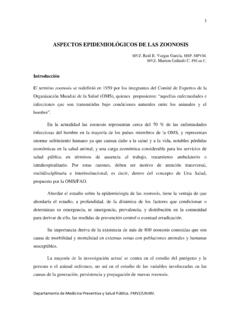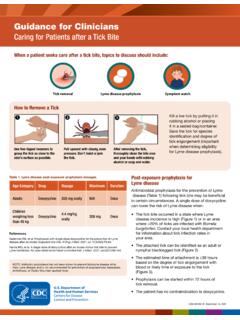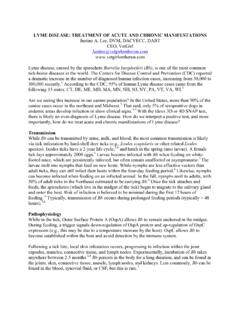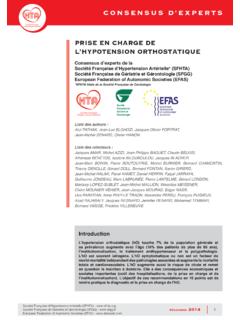Transcription of TICKBORNE DISEASES OF THE UNITED STATES
1 TICKBORNE DISEASES OF THE UNITED STATESA Reference Manual for Health Care ProvidersFourth Edition, 2017 Tick IDMapsLyme DiseaseBabesiosisAnaplasmosisTularemiaOt her TICKBORNE DiseasesRocky Mountain Spotted FeverEhrlichiosisTick Bites/ PreventionTick IDBLACKLEGGED TICK Ixodes scapularisWhere found: Widely distributed in the northeastern and upper midwestern UNITED : lyme disease , anaplasmosis, babesiosis, and Powassan : The greatest risk of being bitten exists in the spring, summer, and fall. However, adults may be out searching for a host any time winter temperatures are above freezing.
2 Stages most likely to bite humans are nymphs and adult STAR TICK Amblyomma americanumWhere found: Widely distributed in the southeastern and eastern UNITED : Ehrlichia chaffeensis and Ehrlichia ewingii (which cause human ehrlichiosis), tularemia, and STARI. Comments: A very aggressive tick that bites humans. The adult female is distinguished by a white dot or lone star on her back. Lone star tick saliva can be irritating; redness and discomfort at a bite site does not necessarily indicate an infection. The nymph and adult females most frequently bite humans and transmit DOG TICK Dermacentor variabilisWhere found: Widely distributed east of the Rocky Mountains.
3 Also occurs in limited areas on the Pacific : Tularemia and Rocky Mountain spotted fever. Comments: The highest risk of being bitten occurs during spring and summer. Dog ticks are sometimes called wood ticks. Adult females are most likely to bite female Ixodes scapularis tick. Color may : Illustrations are not to IDMapsLyme DiseaseBabesiosisAnaplasmosisTularemiaOt her TICKBORNE DiseasesRocky Mountain Spotted FeverEhrlichiosisTick Bites/ PreventionTick IDBROWN DOG TICK Rhipicephalus sanguineusWhere found: Worldwide. Transmits: Rocky Mountain spotted fever (in the southwestern and along the border).
4 Comments: Dogs are the primary host for the brown dog tick in each of its life stages, but the tick may also bite humans or other Jacobs, PSU EntomologyGROUNDHOG TICK Ixodes cookeiWhere found: Throughout the eastern half of the and Canada. Transmits: Powassan disease . Comments: Also called woodchuck ticks. All life stages feed on a variety of warm-blooded animals, including groundhogs, skunks, squirrels, raccoons, foxes, weasels, and occasionally people and domestic animals. GULF COAST TICK Amblyomma maculatumWhere found: Coastal areas of the along the Atlantic coast and the Gulf of Mexico.
5 Transmits: Rickettsia parkeri rickettsiosis, a form of spotted : Larvae and nymphs feed on birds and small rodents, while adult ticks feed on deer and other wildlife. Adult ticks have been associated with transmission of R. parkeri to MOUNTAIN WOOD TICK Dermacentor andersoniWhere found: Rocky Mountain STATES and southwestern Canada from elevations of 4,000 to 10,500 feet. Transmits: Rocky Mountain spotted fever, Colorado tick fever, and : Adult ticks feed primarily on large mammals. Larvae and nymphs feed on small rodents.
6 Adult ticks are primarily associated with pathogen transmission to hermsi tick, before and after feeding. Photo taken by Gary Hettrick RML, TICK Ornithodoros found: Throughout the western half of the and southwestern Canada. Transmits: Tick-borne relapsing fever (Borrelia hermsii, B. parkerii, or B. turicatae)Comments: Humans typically come into contact with soft ticks when they sleep in rodent infested cabins. The ticks emerge at night and feed briefly while the person is sleeping. The bites are painless, and most people are unaware that they have been BLACKLEGGED TICK Ixodes pacificusWhere found: Along the Pacific coast of the , particularly northern California.
7 Transmits: Anaplasmosis and lyme disease . Comments: Nymphs often feed on lizards, as well as other small animals. As a result, rates of infection are usually low (~1%) in adults. Stages most likely to bite humans are nymphs and adult DiseaseBabesiosisAnaplasmosisTularemiaOt her TICKBORNE DiseasesRocky Mountain Spotted FeverEhrlichiosisTick Bites/ PreventionOverview of TICKBORNE DiseasesSelected TICKBORNE DISEASES Reported to CDC, , 2015 AnaplasmosisBabesiosisEhrlichiosisLyme DiseaseRocky MountainSpotted FeverTularemiaNOTE: Each dot represents one case.
8 Cases are reported from the infected person s county of residence, not necessarily the place where they were : During 2015, babesiosis was reportable in Alabama, Arkansas, California, Connecticut, Delaware, Illinois, Indiana, Louisiana, Kentucky, Maine, Maryland, Massachusetts, Michigan, Minnesota, Montana, Nebraska, New Hampshire, New Jersey, New York, North Dakota, Ohio, Oregon, Rhode Island, South Carolina, South Dakota, Tennessee, Texas, Utah, Vermont, Washington, West Virginia, Wisconsin, and : In 2015, no cases of TICKBORNE illness were reported from Hawaii.
9 In 2015, Alaska reported 1 travel-related cases of lyme disease and 2 cases of DiseaseBabesiosisAnaplasmosisTularemiaOt her TICKBORNE DiseasesRocky Mountain Spotted FeverEhrlichiosisTick Bites/ PreventionAnaplasmosisAGENTA naplasma phagocytophilumWHERE FOUNDA naplasmosis is most frequently reported from the upper midwest and northeastern in areas that correspond with the known geographic distribution of lyme disease . INCUBATION PERIOD: 1 2 weeksSIGNS AND SYMPTOMS Fever, shaking, chills Severe headache Malaise Myalgia Gastrointestinal symptoms (nausea, vomiting, diarrhea, anorexia) Cough Rash (rare cases)The Signs and Symptoms list presents symptoms commonly seen with anaplasmosis.
10 However, it is important to note that few people will develop all symptoms and the number and combination of symptoms varies greatly from person to and ehrlichiosis have similar clinical presentations, but they are transmitted by two different species of ticks and generally occur in different regions of the was formerly known as Human Granulocytic Ehrlichiosis (HGE).Confirmation of the diagnosis is based on laboratory testing, but antibiotic therapy should not be delayed in a patient with a suggestive clinical presentation.


















